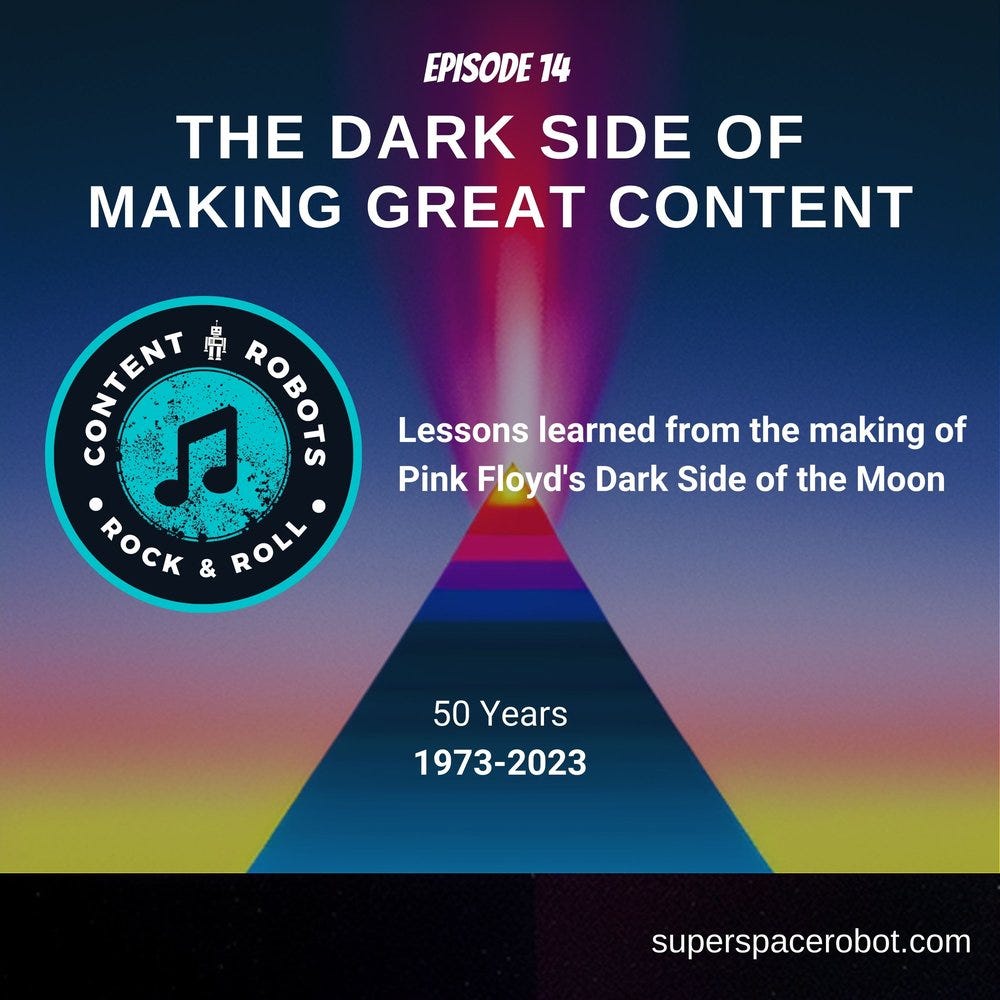Podcast Episode Details
On the date of this publishing, March 1, 2023, Pink Floyd's legendary album, The Dark Side of the Moon, turns 50 years old. With sales of over 45 million copies worldwide, Dark Side holds a special place in the hearts and minds of rock and roll fans. Listen to the podcast to find out about:
Why Pink Floyd's album The Dark Side of the Moon is still so popular 50 years after its release.
How the band used universal, human themes and topics, and experimental production techniques, to enhance the audience's listening experience.
How we can draw a connection between the effective use of early synthesizers in 1970s rock music and the effective use of AI-generated information in modern content marketing.
A Clear Vision
The Dark Side of the Moon is a rare instance where the band had a clear vision for the record they wanted to make, and they had the know-how to get it onto tape. They did it themselves. Pink Floyd self-produced it (with some engineering help from a young Alan Parsons). They stuck to their vision, and they created one of the greatest albums of all time.
The phrase "making your Dark Side of the Moon" has become shorthand for creating your life's best work. It's the pinnacle — the apex — the masterpiece that will never be topped. Let's explore the reasons for that. Why does the album resonate with so many people from the early 1970s up to today? What lessons can we learn from Pink Floyd that we can apply to the content that we make?
Concept Album
The Dark Side of the Moon is a concept album, which means that all the songs are linked thematically and musically. Concept albums were the thing to do in the 1970s. Pink Floyd did it really well here by creating a work made of individual tracks that connect to each other sonically, tonally, and thematically.
A well-made concept album can be an interesting lesson for creators on how to build content that resonates with audiences and creates real experiences.
Thematically, you're probably talking about the same or similar topics, but you might look to other things as well. For example, you might tell a single story with multiple arcs over weeks or months, weaving each topic you want to cover into the narrative.
This tactic might be especially good for use cases, blueprints, or case studies. Think of a case study of a large, successful project that introduces a relatable customer. Over subsequent weeks you can publish additional, thematically compatible stories that go into detail on the specific tasks and strategies enacted for that customer across their business.
Universal Themes
The Dark Side of the Moon came out in the early 1970s - a time that was full of turmoil and uncertainty throughout the world. This album connected with people in a real and visceral way. The album explores universal themes such as death, time, and the human condition, which resonated with audiences around the world. These ubiquitous themes helped to enable that resonance and enhance the overall experience.
Your content may not include themes as dark as death, mental illness, or the fleeting passage of time. There are certainly elements of the human condition that you can use to form authentic connections with your audience. What emotions do you want your audience to feel when they interact with your content? What mindset do you want to emphasize or change in them?
The usage of human themes not only helps you to connect your content together, but it sets you apart from AI-generated content. It also helps you build your brand.
Production
The album's production was groundbreaking for its time, with Pink Floyd using innovative techniques such as quadraphonic sound and careful manipulation of stereo panning. This made for a more immersive listening experience that was a departure from the standard production of the time.
Quadrophonic sound (placing sound in 4 distinct speaker channels vs. 2) never really caught on for music as it did for movies and television (think Dolby Atmos in modern times). Still, listening on a high-fidelity sound system or a good set of headphones will bring some of the intended sound design out in Dark Side. It's quite an experience.
The lesson here would be to choose a medium and format that delivers an impressive and unique experience, yet is accessible to your audience.
Experimentation
Pink Floyd wasn't afraid to try new things and take risks to find the perfect sounds. The album featured a wide range of experimental sounds and techniques, such as the use of spoken word samples, sound effects, and the extensive use of synthesizers. This experimentation helped to push the boundaries of what was possible in popular music and inspired many other artists to experiment with new sounds and techniques.
They asked random questions to people in and around the studio and recorded their answers. The random voices you hear throughout the record came from those sessions.
They did the same thing with sound, using samples like change dropping into a bowl and ringing cash registers, then connecting the tape into a 7-beat loop that would become the 7/4 rhythm track for the song "Money".
This tactic would become trivial in later years with digital technology, but in 1972 and 1973 it involved splicing and connecting small bits of tape and looping it together at the right tempo. Considerable skill, imagination, and creativity were required to achieve that.
Synthesizers
Pink Floyd made use of synthesizers and sequencers in new and interesting ways on The Dark Side of the Moon. I find this topic fascinating because early synthesizers in 1970s rock music seem to correlate significantly with the way we think about AI in modern content creation.
Could you use a late 60s or early 70s analog synthesizer to create an entire record from start to finish and make it sound pretty good? I guess, but after a while, that kind of music becomes rather tiresome, and vapid. Artists like Pink Floyd, and others, used synthesizer technology to enhance or augment their creative vision.
"On the Run", for instance, is a dark and menacing track on side 1 of Dark Side that beautifully and artfully connects the introduction of "Speak to Me" and "Breathe" with the ethereal and epic "Time". That's followed up with one of the most beautiful and goosebump-inducing moments on the entire record: "The Great Gig in the Sky", featuring the majestic, wordless vocals of singer Clare Tory.
The sequence on side 1 of The Dark Side of the Moon was created by brilliant, emotional, talented humans, supported by new technology. Sound familiar?
If not, let's fast-forward 50 years to 2023: the best content we can create with AI is content where AI supports and complements our human creativity, imagination, and point of view.
That's how writers, artists, musicians, and creators of all kinds can stay engaged, relevant, and employed. That's how we can create our "Dark Side" - whatever form that might take for each of us.
I'll See You On The Dark Side of the Moon
Here are two pieces of content that provide more context around this magnificent album:
'Sublime menace and sonic enormity': 50 years of Pink Floyd's The Dark Side of the Moon by Mark Beaumont, published in The Independent
Abigail Devoe's video analysis, Dark Side of the Moon, 50 Years Later
Listen Up!
Here are links to Pink Floyd's The Dark Side of the Moon on Apple Music and Spotify:








The Dark Side of Making Great Content